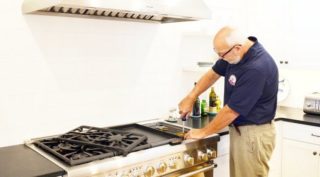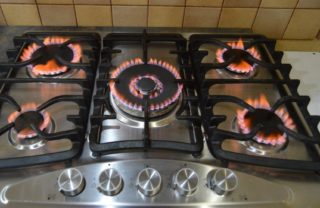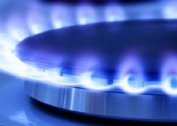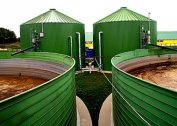During the operation of a gas stove or boiler, methane must burn completely - with the formation of water and carbon dioxide. This requires that the hydrocarbon is mixed with oxygen in a certain proportion. If there is not enough oxygen, the gas burns with a red flame or orange. This is not safe, since products of incomplete oxidation are formed during combustion.
The main causes of flame color change

The gas mixture, which is the fuel for household appliances, is 98% pure methane. Household gas is cleaned before being supplied to the consumer just in order to achieve complete combustion. Such gas in the burner burns with a clear transparent blue fire.
The color of the fire changes with incomplete combustion, with insufficient oxygen supply, with equipment mismatch and other reasons. The color and intensity of the fire can determine what is the reason and what needs to be done.
Yellow or orange flame
Blue fuel is supplied to the burners under slight pressure. Here, methane mixes with oxygen to form a fuel-air mixture that burns with a blue flame. Violation in the process leads to a discoloration of the fire.
Orange or yellow gas from the burner is released, first of all, if the proportions of oxygen and methane are violated. The reason most often is the contamination of the holes through which air is drawn in. Soot or household dust gets into them.
Often a yellow flame is observed at the first use of the stove. After the manufacture of the burner and the tube of the ignition group, an oil film is stored on them. And dust and soot stick to it instantly. Air holes are contaminated, methane burns with an orange flame.
The first thing to do when a yellow gas flame appears is to clean the burners and other elements. To do this, call the wizard.
A change in the color of the fire is accompanied by the appearance of soot, the residual glow of the torch. Often the flame becomes too intense and opaque. With such signs, it is urgent to clean the stove.
Another common reason is the mismatch of equipment and fuel supplied. If the stove is designed to work on a propane-butane mixture, the methane in the burners will not light blue.
Orange or yellow gas from the burner appears when the air damper is in the wrong position. If it falls, jumps off, closes, insufficient oxygen will be supplied to the burner. In this case, the blue fire turns into yellow. To correct the situation, you need to check in which position the shutter is and install it in its place.
Red flame
The reason that the gas burns with a red flame is much more serious. When methane is burned, a very small amount of carbon monoxide is formed, since it is impossible to achieve complete oxidation under domestic conditions. If CO is formed too much, the flame turns red.
Carbon monoxide is an extremely toxic substance. Already at a concentration in the air of 0.01-0.2%, it affects a person, causing severe dizziness, suffocation, loss of consciousness. If the concentration is exceeded, it causes death. In this case, carbon monoxide is neither odor nor color. Changing the color of the fire to reddish is the only visual sign by which its selection can be determined.
Incomplete oxidation occurs for the same reasons: contamination of the suction openings and other burner parts. It is possible that the fuel is supplied under too high a pressure and mixes with oxygen in the wrong proportion.
To check the stove or heater, you must consult a specialist.
Correct color when burning
In order for methane to burn completely and release the greatest amount of heat, it is necessary that the gas mixture contains a sufficient amount of oxygen. The combustion of 1 liter of fuel requires 10 liters of air (oxygen, respectively, 2 liters).
The following signs indicate normal burner operation:
- blue color of fire;
- the flame is transparent, the torch corresponds to the value of the power regulator;
- gas burns silently;
- tongues of fire are distributed evenly around the disk, do not go out at the minimum value of the regulator;
- the burner lights up without popping or other extraneous sounds.
If the oxygen supply is insufficient or the methane pressure is too high, the color of the flame changes, extraneous noise appears.
Troubleshooting color changes
The main cause of the malfunction is pollution. You can eliminate yellow and even red flames by simply cleaning the burners. In difficult cases, when it is necessary to exchange the nozzle or adjust the level of mixing of methane and oxygen, the help of a specialist is required. To remove pollution, no skills are needed.
The recommendations are simple:
- metal and enameled surfaces are cleaned with liquid means, abrasive can not be used;
- glass ceramics are washed with a soap solution;
- the holes are cleaned with a stiff brush;
- chlorine-containing agents cannot be used - these compounds burn with methane;
- after washing, wipe the stove with a dry cloth.
Dust accumulating on the surface of the stove, together with air, enters the burner. Here it is charred, melted and sticks to the surface of the channel. It turns out to be difficult to remove.
If after cleaning and cleaning the color of the fire has not changed, contact the gas service.
Prevention and exclusion of a defect
You should carefully choose gas equipment so as not to buy a stove or boiler designed for working with propane in an apartment with a centralized gas supply.
There are other recommendations.
Learning Operating Rules
Household gas appliances are usually simple, but you must study the operating instructions and carefully follow the safety rules:
- It is forbidden to gasify the house yourself or install gas appliances.
- In no case should glue, transfer or block ventilation shafts, chimney pockets, hatches for cleaning.
- It is forbidden to turn on gas appliances if there is no draft in the chimney, there is no exhaust ventilation or the windows are closed.
- Operating devices should not be ignored, with the exception of those that operate around the clock and are equipped with safety automation.
- It is forbidden to use gas for children under 14 years of age, incapacitated and people in a state of consciousness change: being in a drug or alcohol intoxication, under the influence of psychotropic drugs.
- Do not load the pipes of the gas pipeline — dry things, attach ropes for drying to them, and so on.
- If there is a smell of gas, you must immediately turn off all gas appliances, turn off the taps, open all the windows in the apartment, leave the room. Call the emergency gas service.
For different devices there are special recommendations. For example, if in the burner of a gas stove flame tongues come off or the color changes to orange or red, you need to turn off the stove and call the gasman. The geyser can only be turned on if there is traction. The check is done twice: before turning on and after.Before turning on the boiler, for this you need to open the chimney damper.
Instrument Care
The homeowner is responsible for the normal operation of gas appliances. In practice, this means close cooperation with representatives of gas companies, since it is forbidden to repair or carry out technical inspection of the equipment.
The rules are as follows:
- The surface of gas appliances should be cleaned periodically. When dust enters the burner, the oxygen supply deteriorates and methane burns inefficiently.
- Gas cylinders should only be refilled at specialized points.
- After connecting a new cylinder, it is necessary to check the tightness of the connection: apply soap solution to these areas.
- Follow the instructions exactly, do not overheat the device.
- Installation, commissioning, inspection, repair of gas equipment is performed only by employees of the gas company. It is the responsibility of the owner to report faults, if any, in a timely manner and to provide access to devices.
Only external parts may be cleaned. Disassemble and clean the burner only by a qualified gas specialist.
In case of malfunction, contact a specialist
In the event of a suspicious whistle, a gas odor, a change in the color of the fire, damping, lack of traction and other cases, the devices are turned off, cut off the gas supply and immediately call specialists.
If the breakdown is not accompanied by a gas leak, they call the employees of the gas company servicing the apartment or house. If there is a smell of gas in the home, they turn to the emergency service and duplicate the call to the firemen.








